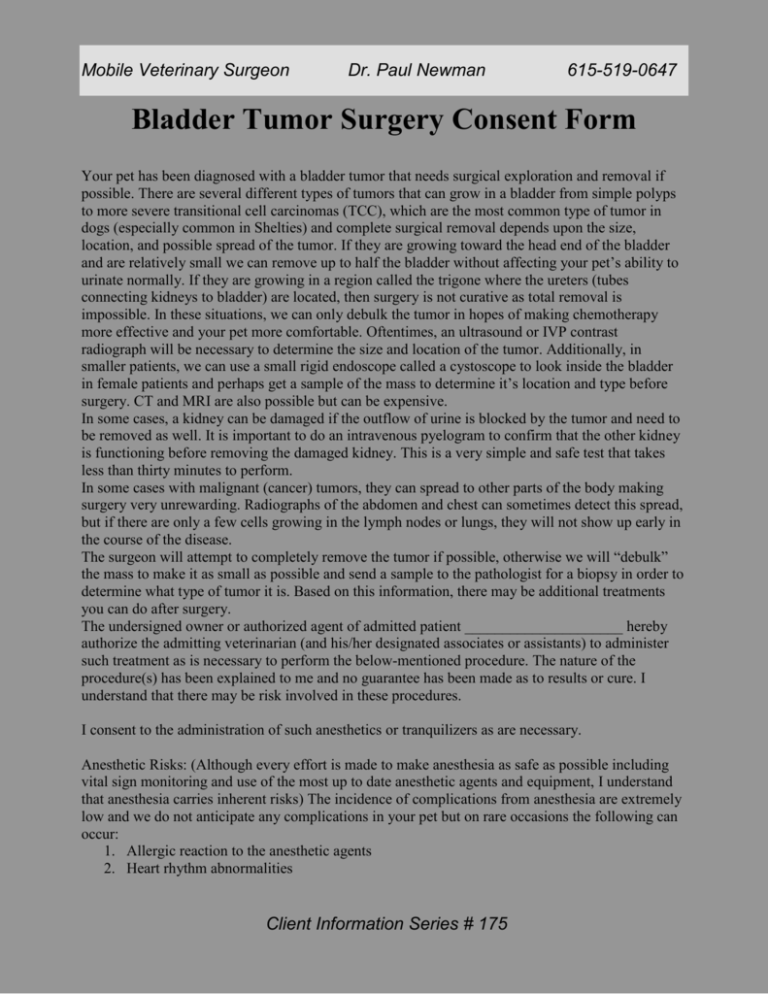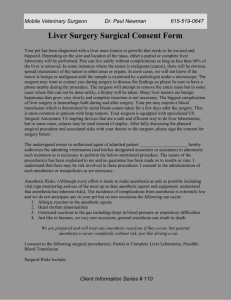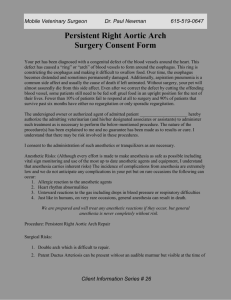Glucose Curve Procedure For Diabetics
advertisement

Mobile Veterinary Surgeon Dr. Paul Newman 615-519-0647 Bladder Tumor Surgery Consent Form Your pet has been diagnosed with a bladder tumor that needs surgical exploration and removal if possible. There are several different types of tumors that can grow in a bladder from simple polyps to more severe transitional cell carcinomas (TCC), which are the most common type of tumor in dogs (especially common in Shelties) and complete surgical removal depends upon the size, location, and possible spread of the tumor. If they are growing toward the head end of the bladder and are relatively small we can remove up to half the bladder without affecting your pet’s ability to urinate normally. If they are growing in a region called the trigone where the ureters (tubes connecting kidneys to bladder) are located, then surgery is not curative as total removal is impossible. In these situations, we can only debulk the tumor in hopes of making chemotherapy more effective and your pet more comfortable. Oftentimes, an ultrasound or IVP contrast radiograph will be necessary to determine the size and location of the tumor. Additionally, in smaller patients, we can use a small rigid endoscope called a cystoscope to look inside the bladder in female patients and perhaps get a sample of the mass to determine it’s location and type before surgery. CT and MRI are also possible but can be expensive. In some cases, a kidney can be damaged if the outflow of urine is blocked by the tumor and need to be removed as well. It is important to do an intravenous pyelogram to confirm that the other kidney is functioning before removing the damaged kidney. This is a very simple and safe test that takes less than thirty minutes to perform. In some cases with malignant (cancer) tumors, they can spread to other parts of the body making surgery very unrewarding. Radiographs of the abdomen and chest can sometimes detect this spread, but if there are only a few cells growing in the lymph nodes or lungs, they will not show up early in the course of the disease. The surgeon will attempt to completely remove the tumor if possible, otherwise we will “debulk” the mass to make it as small as possible and send a sample to the pathologist for a biopsy in order to determine what type of tumor it is. Based on this information, there may be additional treatments you can do after surgery. The undersigned owner or authorized agent of admitted patient _____________________ hereby authorize the admitting veterinarian (and his/her designated associates or assistants) to administer such treatment as is necessary to perform the below-mentioned procedure. The nature of the procedure(s) has been explained to me and no guarantee has been made as to results or cure. I understand that there may be risk involved in these procedures. I consent to the administration of such anesthetics or tranquilizers as are necessary. Anesthetic Risks: (Although every effort is made to make anesthesia as safe as possible including vital sign monitoring and use of the most up to date anesthetic agents and equipment, I understand that anesthesia carries inherent risks) The incidence of complications from anesthesia are extremely low and we do not anticipate any complications in your pet but on rare occasions the following can occur: 1. Allergic reaction to the anesthetic agents 2. Heart rhythm abnormalities Client Information Series # 175 Mobile Veterinary Surgeon Dr. Paul Newman 615-519-0647 3. Untoward reactions to the gas including drops in blood pressure or respiratory difficulties 4. Just like in humans, on very rare occasions, general anesthesia can result in death. We are prepared and will treat any anesthetic reactions if they occur, but general anesthesia is never completely without risk. Procedure: Epidural, Cystotomy (opening up the bladder) and tumor removal or debulking Surgical Risks: 1. Regrowth of the tumor, especially if it is malignant 2. Spread of the tumor to other locations in the body if it is malignant 3. Dehiscense (suture line breakdown) of the incision into the bladder or the abdomen, especially if the bladder is abnormal, leading to urine leakage into the abdomen and additional surgery at additional cost 4. Infection (rare) can occur in about 3% of cases. 5. Blood can occur in the urine for up to two weeks after surgery which is normal as long as it is a small amount and getting better daily. When blood mixes with urine it can appear to be a lot of bleeding when it is not 6. Painful urinations for a few days ______________________________________________________________________________ Date Pet Owner/Agent Signature Phone I Can Be Reached At Today Client Information Series # 175









